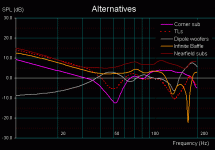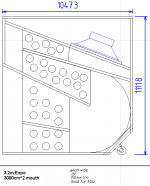When I built my Stryke Thunder 12.3 cabinet for my AV12 woofer, it turned out really huge and heavy. I have been considering a smaller, sealed box for the AV12. When I look at simulated responses of the enclosures and use them to predict what the low end will be like, should I really take room gain into consideration or would its effect be mostly negligible? While I have too much money invested in my current enclosure, with the high price of passive radiators and whatnot, I am considering building another, smaller subwoofer that I can use upstairs in my room. Then I can just put my big subwoofer in storage until I come back to Purdue (yeah, doin' the college thing) next year. This information will come in handy for that project.
have been considering a smaller, sealed box for the AV12
I wouldnt use a sealed box for HT unless i enjoyed quiet bass.Check up the power handling in WINISD PRO or similar program between sealed and ported.
For typical lounge roomsI really take room gain into consideration or would its effect be mostly negligible?
-room gain will only be in effect from ~25hz and under-and it will not be the theoretical 12db/octave increase below room resonance- due to imperfect room -leakage etc.
175litres internal, or ~210litres external -huge?thats how large mine is-its a pain when i move house,but i dont very often.it turned out really huge and heavy.
Cheers!
Bam,
Room gain is definately something to consider, especially with a vented or PR alignement. You can simulate to get an idea with the FRDC calculator. My room sims to about a first order gain that starts at 40 Hz. This helps to improve the low end of a sealed sub. A typical sealed sub needs only 6db of eq to get down to 20 Hz in that setup.
One alternative is to put a small sealed sub right next to your couch or behind ... like a coffee table. Room gain and room modes then have very little effect. Output is increased without using corner loading and all the associated room modes.
I plan to put my AV12s in small sealed boxes, partly from a style point of view.
In you case a small sealed sub can be cheaper, simpler, easier to put into a room, and more house mate friendly. (The sub will blow you away more than them, just by being closer to it) Just put it in a downfiring couchside 1.5 cu ft box with a linkwitz transform if desired. You don't even need to make a grille.
Room gain is definately something to consider, especially with a vented or PR alignement. You can simulate to get an idea with the FRDC calculator. My room sims to about a first order gain that starts at 40 Hz. This helps to improve the low end of a sealed sub. A typical sealed sub needs only 6db of eq to get down to 20 Hz in that setup.
One alternative is to put a small sealed sub right next to your couch or behind ... like a coffee table. Room gain and room modes then have very little effect. Output is increased without using corner loading and all the associated room modes.
I plan to put my AV12s in small sealed boxes, partly from a style point of view.
In you case a small sealed sub can be cheaper, simpler, easier to put into a room, and more house mate friendly. (The sub will blow you away more than them, just by being closer to it) Just put it in a downfiring couchside 1.5 cu ft box with a linkwitz transform if desired. You don't even need to make a grille.
Interesting. How does putting the sub beside a couch help with room mode issues? Are you thinking of nearfield working?
A while ago, I tried a sub close to me (side of couch) and I found I could locate it, but without changing the upper crossover frequency and moving it closer to my mains it integrated much better. I admit this is not the same thing as room mode issues, but being able to locate a sub is IMO just as bad as having room mode issues.
I'm now building two tiny subs with really nice drive units, so will experiment with this again soon. Maybe I just need to set things up better/have lower upper F3 (was about 80Hz 4th-order).
A while ago, I tried a sub close to me (side of couch) and I found I could locate it, but without changing the upper crossover frequency and moving it closer to my mains it integrated much better. I admit this is not the same thing as room mode issues, but being able to locate a sub is IMO just as bad as having room mode issues.
I'm now building two tiny subs with really nice drive units, so will experiment with this again soon. Maybe I just need to set things up better/have lower upper F3 (was about 80Hz 4th-order).
When you are next to the sub somewhere in the middle of the room, the direct field dominates the response and not room modes. In a typical room, room modes are virtually eliminated. Virtually all other locations have room mode issues that make eq and/or room treatment essential. Ceiling mounted IB installations can also have a similar effect, while have the advantage of being a similar distance as the mains.
I believe localisation issues relate are caused by:
1. distortion which introduces additional output above the passband of the sub
2. choice of crossover point and slope
The best sub setup I have seen had 5 subs and two processors (Ultradrive and Ultracurve) and it was difficult to localise the subs even when your ear was right up next to the subs within about 1 ft. The cost of those processors, however, is probably more than most would spend in total on a sub! I believe he crossed at 80 Hz which is actually quite high.
This is something that needs experimentation to get the best for your room.
Here is a simulation showing some different options in my room, which is a fairly typical Australian living room, with timber floor and plasterboard construction. The chart shows the room with a fair amount of treatment and the curves show mains (TLs - dotted red line). The direct field subs (one either side of couch) are shown in maroon (brown red) and the IB option has two IB's located in two locations (after trying many different locations - in this case they were placed 1m in from the corners diagonally opposite each other).
I believe localisation issues relate are caused by:
1. distortion which introduces additional output above the passband of the sub
2. choice of crossover point and slope
The best sub setup I have seen had 5 subs and two processors (Ultradrive and Ultracurve) and it was difficult to localise the subs even when your ear was right up next to the subs within about 1 ft. The cost of those processors, however, is probably more than most would spend in total on a sub! I believe he crossed at 80 Hz which is actually quite high.
This is something that needs experimentation to get the best for your room.
Here is a simulation showing some different options in my room, which is a fairly typical Australian living room, with timber floor and plasterboard construction. The chart shows the room with a fair amount of treatment and the curves show mains (TLs - dotted red line). The direct field subs (one either side of couch) are shown in maroon (brown red) and the IB option has two IB's located in two locations (after trying many different locations - in this case they were placed 1m in from the corners diagonally opposite each other).
Attachments
mike.e said:i cant fit my 200litre jbl in the middle of the room haha!
Hmmmm, perhaps a horn loaded couch subwoofer
(if you have ever had the urge to design your own couch)
It wouldnt take too long with a holesaw attachment
-MDF is heavy enough.
You would assume that there would be some turbulence due to the sharp edges-but the high velocity is at the horn mouth not the horn throat. Bills designs have holey bracing with no ill effects-many basshorns have sharp corners on the MDF/ply with no ill effect.
The bandwidth is only 30hz-90hz anyway.
Cheers!
-MDF is heavy enough.
You would assume that there would be some turbulence due to the sharp edges-but the high velocity is at the horn mouth not the horn throat. Bills designs have holey bracing with no ill effects-many basshorns have sharp corners on the MDF/ply with no ill effect.
The bandwidth is only 30hz-90hz anyway.
Cheers!
BAM said:Gee, I'd hate to cut all those little holes in the braces of that horn design! I also imagine they'd make a fair bit of turbulence.
Remember those are much bigger openings than a vent in a subwoofer, and the driver would not normally be displacing as much air, and at the same time, the output is so much more to mask any turbulence. The smallest internal part is probably 16" at least wide.
- Status
- This old topic is closed. If you want to reopen this topic, contact a moderator using the "Report Post" button.
- Home
- General Interest
- Room Acoustics & Mods
- Subwoofers, Anechoic FR, and Room Gain

